The previous posts First one / Second one
The day did not start well: first we were woken at 4 in the morning by a rather enthusiastic waiter, who, the previous night took his tea order right but not the room to which the order had to be delivered. Instead of realising that it was improper to wake people up so early, he was insisting that this was the room to which it had to be delivered. Half believing me, he yelled to his friend who must have been at the end of the corridor to double check the room. His friend yelled back that he got the room wrong. “Sorry sir-ji”, our ‘polite’ youth said and went to loudly knock the room few doors further.
This woke me up completely and I realised I had a frog in my throat. Not a good sign since that means a cold is around the corner. I have a strange warning mechanism for a cold: first I wake up with a sore throat that too on ONE side (I am not joking), then as the pain disappears the nostril on the erstwhile sore part starts to go on an overdrive and then the next nostril suddenly remember it needs to act in tandem with its sibling . Strange isn’t it? Well each of us are as strange as our own ailments.
After tossing around for a while on the bed and when it was light enough, I went to inform the manager that he can arrange to send hot water to my room, he was not in his seat and the kitchen folks casually mentioned, while warming themselves at the cook-stove, that the boiler broke down and we have to make do with cold water, if we intend having a bath at all. The water was freezing to say the least. I then remembered my bathing scheme in Pune/Hyderabad in winters (we did not have a geyser): pour water on feet first… then on knees… shiver… then stare hard at the water in the bucket expecting to warm it a la superman and in a swift movement douse the entire body supported by appropriate squirms and screams. I must add that after the first few mug-fulls the batch actually starts to be enjoyable. I tried to emulate the same routine here but it was more pride than cleanliness that prompted me to perform the drill.
Having accomplished this feat, I went over to adjoining room where my friends were still lolling in bed, told them that there is no hot water and that I went through my ablutions with cold water, as befitting anyone wanting to scale the might Himalayas. One of them was not amused. He had a fight with manager who promptly got hot water organised for him and others. Wife gave me icicle laden stares for she succumbed to my motivating talk a little earlier. Anyway, casually casting those stares aside, and with a head stuck out like a proud rooster, I went to the restaurant and polished few hot alu-parathas not-withstanding the sore food passage. With mango-pickle burps and a satisfied stomach, I limbered up a bit by walking around the campus taking a snap here and there as I waited for the rest to take a short ride to Gaurikund where the path to Kedar starts.
The ride to Gaurikund with some spectacular views of the sun-kissed mountains, in ideal conditions should have taken ten minutes. In reality it took close to an hour. The first seven minutes were close to the ideal state but the next three minutes weren’t as we ran into a long line of vehicles, all at a standstill, waiting to get to Gaurikund. Two of us jumped out to do some restless and pointless activities. Before we could get a porter to haul our luggage to the main gateway, the vehicles started to inch ahead. The brown kucha road was little wider than two vehicles and there were whole bunch of people (porters, drivers, cleaners, bhel-wala, etc.) creatively taking up all kinds of spaces – tree stumps, jutting rocks, rubbish mounds. A slow and careful ride (not to knock other vehicles into the steep valley or spread smiling Nepalese nicely along the mountain wall) took us to a little square half the size a foot ball field. To say it was chaotic was to say the least. There were about a 100 vehicles, half of them discharging their load of giggling enthusiastic families all eager to jog up the 14 km path to Kedar; other half picking up weary families wondering why on earth were they so enthusiastic and eager to get some brownie points, that too for a supposedly next life. In between these vehicles were families waiting impatiently for their vehicles to turn up so that they can put behind as much distance as possible from this place. In total it was chaos of a new order. The fact that all this happens without much ado is a miracle in itself. Actually there were also some folks with that ‘been there and done it” kind of look but they were the fat folks who did the trek on other beings.
We gave the customary dip in the Kund before the trek to Kedar a miss, and went on to pass through the welcoming arch and throbbing crowds onto a stone paved path with varying commercial activities on its sides. Lugging our loads to the GMVN (the state run guest house), where our driver said that the staff will help us get a good porter. They were trying to palm some of their cronies who were asking more than normal rates, which obviously included some generous kickbacks here and there. I enthusiastically volunteered to keep an eye on the luggage so that the others can span out to find a porter willing to transport our luggage at a price that was comfortable for us. I love my friends when they fall for such displays of unbridled enthusiasm.
Each of us kept a small backpack with a bottle of water. I volunteered to carry two extra bottles of water. Folks, you may smile at my brag about these bottles, but let me tell you hoisting two extra kg all along the path that winds 14 km in length and two km up into the sky is no mean feat. This is the kind of trek, half way through lazy bums like me would have realised their folly of not cutting those finger-nails and thereby shedding few grams.
Anyway, the first km was the hardest part thanks to the crowds. In addition to the normal demography found at the Gaurikund square, the path also houses ponies, dholies (palanquins) with their fat inhabitants and lean carriers and porters carrying very young or very old in baskets tied to their foreheads and waist. And doing their wee bit to give a quaint farm smell were the pony droppings. Amidst all these, sights and sounds of gushing, milky Mandakini on our left was the only positive
Thursday, December 28, 2006
Wednesday, December 27, 2006
Chettinad trip (made a year ago)
There are two ways to experience Chettinad heritage. For the sake of comparison let me say one is easy and the other is difficult. Naturally, the experience each one offers is slightly different from the other since the efforts involved are different. The easy way is to experience it in Chennai and the difficult way is to experience it in Chettinad itself. There are places in Chennai where one can eat Chettinad food, visit a traditional Chettinad house and then purchase Chettinad crafts. Perhaps, as it was for me, starting out in Chennai may be an easy choice for many.
There are many places to eat authentic Chettinad food (I am a sucker for food, so I believe what the blurbs on name boards and menu cards say). Some of the more prominent ones are Anjapaar, Ponuswamy and Kaaraikudi. These hotels have a number of branches and hence are well spread out in the city. So if you want to eat a Chettinad meal, It is quite likely that the area in which you are will have a branch of these restaurants nearby. Then to visit a Chettinad house, you could visit DakshinaChitra, an open air museum of South Indian Culture started by an American lady Dr. Deborah Thiagarajan. This centre is now the home many authentic houses from Kerala, TN, AP and Karnataka. They have been dismantled, numbered carefully and reconstructed to the original form. Along with these architectural experiences, one can browse around in the craft shop that showcases handicrafts from these states. On weekends and during festival seasons, one can see how some of these crafts are produced. To pick up exclusive crafts from Chettinad, one can head towards M.Rm.Rm Foundation set up and run by Mrs. Visalakshi Ramaswamy. She has revived many crafts forms and has received International recognition. One can purchase Kottans (lovely woven baskets for which UNESCO has given their seal of recognition for this crafts), Attangudi Tiles (floor tiles made in vivid colours and designs that don the traditional houses) and handwoven sarees both in cotton and in silk with typical Chettinad designs. One can set aside a day to experience at a leisurely pace or can run through these sights and tastes in half a day.
There are many ways in which one can experience Chettinad heritage in Chettinad region and my Chettinad experiences have been in bits and pieces over the years. The source can be traced to Chennai years ago. I was in this city for a cousin’s wedding and I a missed opportunity to eat at a ‘Chettinad’ restaurant. Considering that I like food very much it was quite natural that I felt disappointed and wanted to make amendments the next time I was in the city. I had to wait for about 12 years for that. Due to some chance happening I moved to live in Chennai and after we settled I wanted to fulfil that desire of eating Chettinad food. Naturally as a newbie to the city, I asked acquaintances about which restaurant to go to. In addition to some names of restaurants, I was told that this cuisine is more renowned for its non veg preparations and that I, a vegetarian, will have limited choice. Nonetheless, when an opportunity presented itself, I took a Dutch friend of mine, who appreciates many good things about India including the spicy food, to Kaaraikudi, a restaurant chain that specialises in Chettinad cuisine. During the days that preceded this dinner, when my friend and I ate out, kozhambu (tamarind based chutney) was something both of us liked very much. So we were quite happy to order poondu kozhambu (with large pieces of garlic in it) and kathirikai kozhambu, (with eggplant) along with Chettinad Biryani and Malabar Parata. The waiter recommended crispy valiapoo vadai (banana flower vada) as starters. Frankly, there was not much of a choice for a veggie but then when the food did arrive, we did not speak a single word during the entire meal; it was just appreciative nods all the way. Although I ate this meal over a year ago the fact that I can still recall the menu seem to indicate that I have an elephantine memory but it is not so. Considering that I have gone back to this restaurant few times and considering that there is little to choose for a vegetarian, it is not difficult to jog the memory (and the taste buds too)
Taking into account that we were to take a group of Dutch tourists on a food tour of south India, after the first meal itself, we decided to explore possibilities of including Chettinad in the tour. My friend left for his home that night and it was my responsibility to investigate. After couple of months of casual research, I had some information and few cancelled train tickets. With time not entirely on our side, my friend, who arrived just before the trip started, managed to organise a day long trip for himself from Madurai. Strangely, I was in The Netherlands then. His feedback was that the roads were bad but it would be extremely interesting for the group to spend a day visiting some of the temples and then to have a meal at Bangla, a restored mansion in Karaikudi that now operated as a heritage hotel. The plan was to leave early in the morning from Madurai, go to Pilliarpatti, where the morning aarti is carried out at 9 AM. Then go to Kundrakudi a Murugan temple on a large rock. Subsequently we planned to go to Kannadukattan, the main Nathukottu Chetiar’s village and finally to Bangla for lunch.
Although we started early, we could not get to Pilliarpatti by 9AM, we were little late. We jumped off the bus and rushed straight into the temple, the aarti was just getting over. We saw the last part of the aarti and even that was quite impressive. The plate with burning camphor circling around an impressive 6 ft Karpaga Vinayaka idol, accompanied with live music and temple bells was quite celestial. Since the group could not enter temples in Kerala or the Meenakshi temple in Madurai, this was the first entry into a Temple for some of them, they I am sure would have been more impressed then I was.
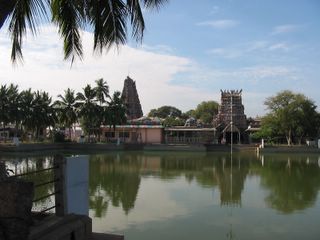
Pillayarpatti temple
Although, the priests told us we could take snaps as long as the deity is not in the picture frame but the guards and the security personnel did not allow us to do so. Since I could not speak Tamil, it was not possible to explain that the priests gave their consent. The next best thing to do was to look for the priests but they were nowhere to be seen. We wandered out and then walked around the temple for a little while. I took some surreptitious snaps as I walked out but none of came out right. Meanwhile, the group got even more disbursed - some members were busy buying trinkets from the shops, couple of others were busy taking snaps of the cows, few were walking around the temple zone and some headed back to the bus. It took a little while to gather them and be on the way to Kundrakudi.
Kundrakudi is famous for a Murgan temple situated on a large rock. At the base of the rock is a small temple with lovely paintings all around, including on the roof. To get to the main temple one has to climb a flight of steps carved into the rock. Even though it was the middle of the day, the climb was not difficult, with gentle breeze and sylvan sights to assist you.
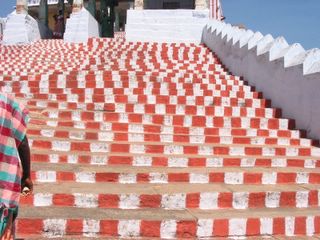
Temple steps
On the right side of the rock was the village with its ‘country tile’ roofs and the left side was natural landscape that extended for quite a distance. Amidst the village one could see the large temple chariot towering over the roofs. It was festooned with mango leaves from a recent temple festival. Once in the temple, I sat in a corner to watch the people. The group wandered around smiling and saying hello to the people. Little kids encouraged by the family came up shyly to shake hands with them. Some of the lesser shy ones asked the group for their names, as the rest of their family stayed in the background, beaming with pride. I can tell that it takes a lot of guts to go up to a stranger and ask for their names, that too strangers from distant lands. I don’t think I can still do that, so I thought the families have all the reason to beam and be proud of their kids.
After few more km of bad roads, we finally arrived at Kannadukattu. A winding path from the edge of the village lead up to the main attraction: the raja’s palace. As we drove into the village the sights the villages had to offer were quite surreal: considering that the village was middle of no-where it had some of the most massive mansions I have ever seen. The group must be even more dazed to see them. The palace where the wealthiest of the Chettiars lived was newly painted. I guess, it was more because of the wealth and the land this family controlled, the head of it was called the Raja and his residence has come to be known as ‘the palace’. Later on I came to know that this place gets painted every January. Since we visited in mid-February, the paints were still bright. While the group went in, I walked around the village to take a few photos. Two more bus loads of overseas tourists came in.
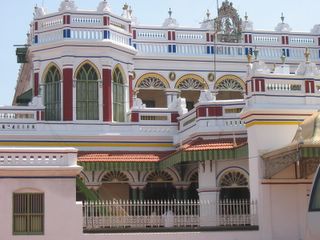
The raja's palace
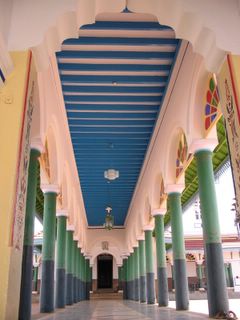
The passage from the entrance to the 'palace'
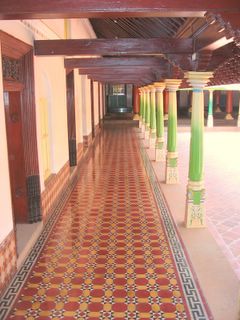
Athangudi tiled passage
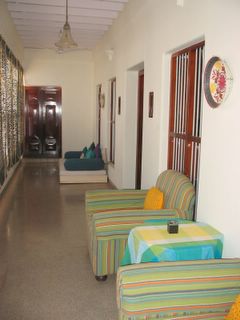
Verandah in Bangla
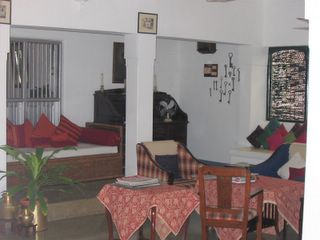
Waiting area in the Bangla
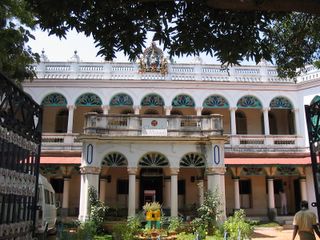
One of the heritage hotels
I guess Chettinad is finally getting onto the tourist map of the country but unfortunately it is the overseas visitors that seem to throng to this place. The only other people who throng this place are antique hunters who carry the dismembered parts of a Chettiyar house to where ever they can sell at exorbitant prices. Next time I am in the Chettinad region, I will make some time to pick up some good deals so that a part of Chettinad is always close by.
There are many places to eat authentic Chettinad food (I am a sucker for food, so I believe what the blurbs on name boards and menu cards say). Some of the more prominent ones are Anjapaar, Ponuswamy and Kaaraikudi. These hotels have a number of branches and hence are well spread out in the city. So if you want to eat a Chettinad meal, It is quite likely that the area in which you are will have a branch of these restaurants nearby. Then to visit a Chettinad house, you could visit DakshinaChitra, an open air museum of South Indian Culture started by an American lady Dr. Deborah Thiagarajan. This centre is now the home many authentic houses from Kerala, TN, AP and Karnataka. They have been dismantled, numbered carefully and reconstructed to the original form. Along with these architectural experiences, one can browse around in the craft shop that showcases handicrafts from these states. On weekends and during festival seasons, one can see how some of these crafts are produced. To pick up exclusive crafts from Chettinad, one can head towards M.Rm.Rm Foundation set up and run by Mrs. Visalakshi Ramaswamy. She has revived many crafts forms and has received International recognition. One can purchase Kottans (lovely woven baskets for which UNESCO has given their seal of recognition for this crafts), Attangudi Tiles (floor tiles made in vivid colours and designs that don the traditional houses) and handwoven sarees both in cotton and in silk with typical Chettinad designs. One can set aside a day to experience at a leisurely pace or can run through these sights and tastes in half a day.
There are many ways in which one can experience Chettinad heritage in Chettinad region and my Chettinad experiences have been in bits and pieces over the years. The source can be traced to Chennai years ago. I was in this city for a cousin’s wedding and I a missed opportunity to eat at a ‘Chettinad’ restaurant. Considering that I like food very much it was quite natural that I felt disappointed and wanted to make amendments the next time I was in the city. I had to wait for about 12 years for that. Due to some chance happening I moved to live in Chennai and after we settled I wanted to fulfil that desire of eating Chettinad food. Naturally as a newbie to the city, I asked acquaintances about which restaurant to go to. In addition to some names of restaurants, I was told that this cuisine is more renowned for its non veg preparations and that I, a vegetarian, will have limited choice. Nonetheless, when an opportunity presented itself, I took a Dutch friend of mine, who appreciates many good things about India including the spicy food, to Kaaraikudi, a restaurant chain that specialises in Chettinad cuisine. During the days that preceded this dinner, when my friend and I ate out, kozhambu (tamarind based chutney) was something both of us liked very much. So we were quite happy to order poondu kozhambu (with large pieces of garlic in it) and kathirikai kozhambu, (with eggplant) along with Chettinad Biryani and Malabar Parata. The waiter recommended crispy valiapoo vadai (banana flower vada) as starters. Frankly, there was not much of a choice for a veggie but then when the food did arrive, we did not speak a single word during the entire meal; it was just appreciative nods all the way. Although I ate this meal over a year ago the fact that I can still recall the menu seem to indicate that I have an elephantine memory but it is not so. Considering that I have gone back to this restaurant few times and considering that there is little to choose for a vegetarian, it is not difficult to jog the memory (and the taste buds too)
Taking into account that we were to take a group of Dutch tourists on a food tour of south India, after the first meal itself, we decided to explore possibilities of including Chettinad in the tour. My friend left for his home that night and it was my responsibility to investigate. After couple of months of casual research, I had some information and few cancelled train tickets. With time not entirely on our side, my friend, who arrived just before the trip started, managed to organise a day long trip for himself from Madurai. Strangely, I was in The Netherlands then. His feedback was that the roads were bad but it would be extremely interesting for the group to spend a day visiting some of the temples and then to have a meal at Bangla, a restored mansion in Karaikudi that now operated as a heritage hotel. The plan was to leave early in the morning from Madurai, go to Pilliarpatti, where the morning aarti is carried out at 9 AM. Then go to Kundrakudi a Murugan temple on a large rock. Subsequently we planned to go to Kannadukattan, the main Nathukottu Chetiar’s village and finally to Bangla for lunch.
Although we started early, we could not get to Pilliarpatti by 9AM, we were little late. We jumped off the bus and rushed straight into the temple, the aarti was just getting over. We saw the last part of the aarti and even that was quite impressive. The plate with burning camphor circling around an impressive 6 ft Karpaga Vinayaka idol, accompanied with live music and temple bells was quite celestial. Since the group could not enter temples in Kerala or the Meenakshi temple in Madurai, this was the first entry into a Temple for some of them, they I am sure would have been more impressed then I was.

Pillayarpatti temple
Although, the priests told us we could take snaps as long as the deity is not in the picture frame but the guards and the security personnel did not allow us to do so. Since I could not speak Tamil, it was not possible to explain that the priests gave their consent. The next best thing to do was to look for the priests but they were nowhere to be seen. We wandered out and then walked around the temple for a little while. I took some surreptitious snaps as I walked out but none of came out right. Meanwhile, the group got even more disbursed - some members were busy buying trinkets from the shops, couple of others were busy taking snaps of the cows, few were walking around the temple zone and some headed back to the bus. It took a little while to gather them and be on the way to Kundrakudi.
Kundrakudi is famous for a Murgan temple situated on a large rock. At the base of the rock is a small temple with lovely paintings all around, including on the roof. To get to the main temple one has to climb a flight of steps carved into the rock. Even though it was the middle of the day, the climb was not difficult, with gentle breeze and sylvan sights to assist you.

Temple steps
On the right side of the rock was the village with its ‘country tile’ roofs and the left side was natural landscape that extended for quite a distance. Amidst the village one could see the large temple chariot towering over the roofs. It was festooned with mango leaves from a recent temple festival. Once in the temple, I sat in a corner to watch the people. The group wandered around smiling and saying hello to the people. Little kids encouraged by the family came up shyly to shake hands with them. Some of the lesser shy ones asked the group for their names, as the rest of their family stayed in the background, beaming with pride. I can tell that it takes a lot of guts to go up to a stranger and ask for their names, that too strangers from distant lands. I don’t think I can still do that, so I thought the families have all the reason to beam and be proud of their kids.
After few more km of bad roads, we finally arrived at Kannadukattu. A winding path from the edge of the village lead up to the main attraction: the raja’s palace. As we drove into the village the sights the villages had to offer were quite surreal: considering that the village was middle of no-where it had some of the most massive mansions I have ever seen. The group must be even more dazed to see them. The palace where the wealthiest of the Chettiars lived was newly painted. I guess, it was more because of the wealth and the land this family controlled, the head of it was called the Raja and his residence has come to be known as ‘the palace’. Later on I came to know that this place gets painted every January. Since we visited in mid-February, the paints were still bright. While the group went in, I walked around the village to take a few photos. Two more bus loads of overseas tourists came in.

The raja's palace

The passage from the entrance to the 'palace'

Athangudi tiled passage

Verandah in Bangla

Waiting area in the Bangla

One of the heritage hotels
I guess Chettinad is finally getting onto the tourist map of the country but unfortunately it is the overseas visitors that seem to throng to this place. The only other people who throng this place are antique hunters who carry the dismembered parts of a Chettiyar house to where ever they can sell at exorbitant prices. Next time I am in the Chettinad region, I will make some time to pick up some good deals so that a part of Chettinad is always close by.
Subscribe to:
Posts (Atom)
